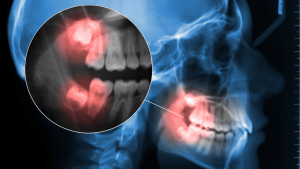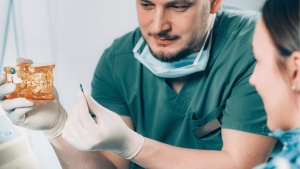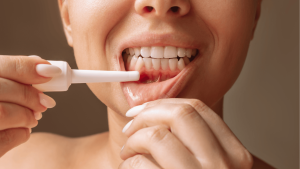Imagine losing a tooth or several, and suddenly you are feeling a little less like yourself. Maybe you are hiding your smile in photos or choosing soft foods instead of your favorites. Chewing is only one aspect of it; other aspects include comfort, confidence, and a sense of completeness. A prosthodontist can help with that. Someone who has studied science and art for years, simply to make you smile again. Wondering? Let’s discover what makes these professionals so outstanding and why they are the unnoticed heroes of sophisticated tooth replacement. We will walk through who a prosthodontist is, what they are trained for, and how they tackle tooth replacement. You will also get an insider look at the treatments they offer and why you might see one instead of going to a regular dentist.
Quick Answer
An expert in complex tooth replacement and restoration, such as crowns, bridges, dentures, and dental implants, a prosthodontist is a dentist with training beyond ordinary dentistry.
They have completed additional postgraduate education (typically 2–3 years) to master both form and function. You are looking at a person who combines artistic talent, precision, and a thorough understanding of oral mechanics to create beautiful, long-lasting smiles.
Therefore, whether you are dealing with missing teeth, severe damage, or complex bite issues, a prosthodontist is the go-to expert who can offer specialized, state-of-the-art solutions.
What Makes Them Unique?
Prosthodontists have received specialized training and possess advanced skills in using prosthetic devices to improve oral health. They specialize in advanced methods, including implant restorations, veneers, full-mouth rehabilitation, and custom-fit dentures.
Imagine needing not just a crown, but the harmony of a full-mouth makeover; keeping your jaw alignment, providing a natural bite, and making sure everything looks (and feels) perfect. Prosthodontists are trained to consider every mechanical, structural, and aesthetic detail.
When a Prosthodontist Is the Right Choice?
If you have complex needs like several missing teeth, failing old dentistry, or planning implants, and you want the best function and appearance, that’s a cue. For example:
- Dentures or bridges anchored with implants
- Full-mouth rehabilitation after trauma or wear
- TMD issues combined with missing or damaged teeth
- Cosmetic reconstruction alongside functional restoration
- Severe tooth wear from grinding (bruxism) that requires rebuilding teeth for both aesthetics and bite stability
Prosthodontists blend the two, so your smile not only looks good but also works harmoniously with your jaw and bite.
Popular Tooth Replacement Options
Let’s discuss what prosthodontists do for patients now that you know when they might be the best option. These are some of the top treatments they provide.
| Procedure | What It Means |
| Restorative crowns and bridges | Replace or restore individual or adjacent teeth |
| Custom-fit prosthetic teeth | Partial or full replacement of teeth |
| Fixed tooth implants | Titanium roots replacing missing teeth; strong and fixed |
| Implant-Supported Prosthetics | Dentures or bridges anchored with implants |
| Aesthetic tooth layers | Cosmetic enhancement, custom, thin facades for teeth |
Other studies and dental expert summaries report dental implant success rates around 95-98% over 10 years with proper maintenance, specialist placement, and advanced surgical techniques.
What Your Smile Journey Looks Like
Your prosthodontist will start with a detailed exam; photos, 3-D scans, maybe even models of your jaw. You will talk about your needs: chewing comfort, appearance, health, and the specialist will design a treatment plan that could span several visits or phases.
They will break down every step in plain language: “Here’s what will happen, how long it will take, what it should feel like,” from temporary restorations to your final smile reveal.
They work with skilled labs where each crown, denture, or veneer is custom-made (some use digital 3-D printing, others handcraft). The result? A fit that feels like it was always yours.
Life After Treatment
Here’s the good part: you will rediscover confident smiles and comfy chewing again. Many patients say it’s like “getting their life back,” eating steak, laughing full-throated, or smiling in photos without covering their mouth.
Plus, with proper care and regular check-ups, many prosthetic solutions last for years or even decades. You may also notice clearer speech, better digestion from improved chewing, and a boost in self-esteem.
Some even find they look younger, thanks to restored facial support. It’s not just a dental fix, it’s a full lifestyle upgrade.
The Bottom Line
A prosthodontist isn’t just a dentist with a fancy title. They are your smile sculptor and function magician, trained to rebuild, restore, and revitalize your oral health, something designed to feel real and stay strong long-term. They make sure your new teeth don’t just look good. They feel good, work right, and give you the confidence to smile freely. How about taking that first step toward a confident, radiant smile? Discover how Popup Smiles can connect you with top prosthodontic care because your smile deserves expert craftsmanship and a caring experience that puts you first, not just the procedure.
Helpful Questions
What’s the difference between a prosthodontist and an oral surgeon when it comes to implants?
A prosthodontist focuses on restoring your smile. The actual tooth replacements, like crowns or dentures, are placed once the implant is in place. An oral surgeon places the implants (the hardware in the bone). They often collaborate: the surgeon places the implants, the prosthodontist designs the final tooth replacements to attach to them.
Can a prosthodontist handle bite alignment disorders (like TMJ) while replacing teeth?
Certainly. Prosthodontists are trained to align the bite, allowing them to address issues with the temporomandibular joint (TMJ) while also replacing teeth, making sure that your jaw, muscles, and restorations work together effectively.
Are digital workflows prevalent in prosthodontics, and how do they enhance results?
Yes, numerous prosthodontists utilize digital scans, CAD/CAM design, and 3-D printing to create more precise restorations, achieve quicker turnaround times, and produce better-fitting prostheses. These digital methods allow for fewer changes, easier fittings, and usually result in more dependable results.






